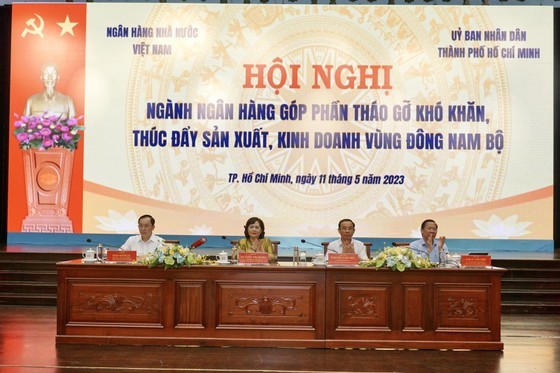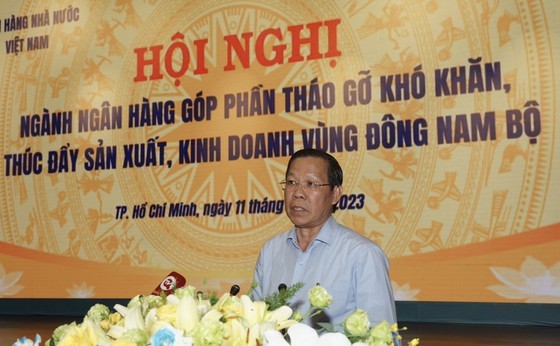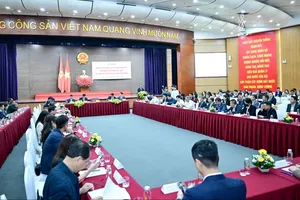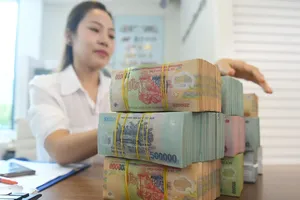 |
At the meeting |
The conference was attended by several dignitaries, including Mr. Nguyen Van Nen, Politburo member and Secretary of the HCMC Party Committee; Mr. Phan Van Mai, Chairman of the People's Committee of HCMC; and Mrs. Nguyen Thi Hong, Governor of the SBV. Additionally, representatives from various localities in the region, relevant departments, agencies, enterprises, business associations, and the banking industry were also present.
Controlling credit into real estate
In his report on credit at the conference, Mr. Dao Minh Tu, Standing Deputy Governor of the SBV, stated that based on the economic growth target of approximately 6.5 percent in 2023 and the inflation rate target of about 4.5 percent set by the National Assembly and the Government, the SBV aims to increase credit growth to around 14-15 percent in 2023, with adjustments made to suit the developments and actual situations to contribute to macroeconomic stability and support reasonable economic growth.
According to the guidance of the SBV, credit institutions should prioritize lending to the production and business sectors, as well as priority areas and economic growth drivers in line with the government's policies. They should also take measures to facilitate customers' access to credit, ensure safe and efficient credit operations, and maintain strict control over credit risks in sectors that are potentially risky.
As of April 27, credit institutions had mobilized capital quite effectively, with a total of VND12.4 quadrillion, equivalent to 101 percent of credit (deposits exceeding loans). System liquidity was abundant, and there was no ceiling limit on credit growth. The total credit for the economy was over VND12.28 quadrillion, up 3.04 percent compared to the end of 2022 and 9.92 percent compared to the same period last year.
In the Southeast region, with a network of nearly 3,500 branches of credit institutions and transaction offices, as well as the People's Credit Fund, capital mobilization had exceeded VND4.1 quadrillion by the end of the first quarter of 2023, accounting for one-third of the total mobilized capital nationwide, down 0.75 percent compared to the end of 2022.
To address difficulties in the real estate market, the SBV has directed credit institutions to continue allocating credit capital to real estate projects that meet legal requirements, have the potential for product consumption, and ensure debt repayment plans, especially social housing, worker housing, and effective low-cost commercial housing projects. The SBV also aims to control credit risks for the luxury real estate segment with excess supply, real estate with no genuine demand, speculative, price-manipulative, and market-cornered real estate. The SBV will control the concentration of credit on some customers, groups of large customers, customers related to major shareholders, customers related to shareholders of credit institutions, and cross-lending, balancing the proportion of credit outstanding in the real estate sector reasonably to ensure the safety of banking operations.
At the same time, there will be strict monitoring and control of credit allocation and fund utilization, particularly to prevent excessive credit concentration in some companies within the ecosystem or in "internal" companies with high risk. Any difficulties or obstacles in the credit work will be timely reported to the SBV’s Governor and other relevant ministries, departments, agencies, and localities to support real estate businesses and projects in resolving issues related to procedures, legal regulations, and project implementation.
As of March 31, 2023, the outstanding real estate credit balance reached about VND2.67 trillion, up 3.51 percent compared to the end of 2022, accounting for 21.83 percent of the total outstanding balance of the economy, with a bad debt ratio of 2.12 percent. Of this amount, the outstanding real estate credit balance in the Southeast region was nearly VND1.1 trillion, a decrease of 1.74 percent compared to the end of 2022, accounting for 41.12 percent of the total outstanding real estate credit balance.
Half of the enterprises opt for moderate production and do not seek credit
During the conference, Mr. Phan Van Mai highlighted the current challenges faced by businesses in HCMC. Specifically, there were 14,752 newly established enterprises with a registered capital of VND144.57 trillion, representing a decrease of 9.59 percent in quantity and 24.79 percent in registered capital compared to 2022. The number of temporarily suspended enterprises increased by 23.88 percent compared to the same period, while foreign investment capital in the city decreased by 23.45 percent in the same timeframe. These statistics serve as an indicator of the overall health of the enterprises.
 |
Mr. Phan Van Mai, Chairman of the People's Committee of HCMC, speaks at the meeting. |
Mr. Phan Van Mai also mentioned the actual issues that HCMC-based businesses are encountering. Specifically, almost 50 percent of enterprises are producing in moderation and have little to no need for credit. Some enterprises require working capital to address short-term payment obligations and enhance their liquidity. These businesses have reported difficulties in adhering to payment schedules for their outstanding loans. Enterprises are hesitant to avail of the preferential credit packages that have been issued, partly due to low demand for credit and partly due to concerns related to relevant authorities. In the real estate sector, buyers are reluctant to take out loans and expect favorable policies.
Mr. Phan Van Mai proposed five recommendations for the banking industry as solutions.
Firstly, the SBV should continue to actively, flexibly, timely, and effectively manage monetary policies, have a stronger orientation towards lending to priority sectors, and fully utilize available sources of capital.
The second solution is to implement coordinated measures for interest rate management to maintain a stable interest rate level, aiming at reducing lending rates to support businesses. Although the interest rate level has decreased, it is still at an average of 10 percent per annum. In reality, enterprises have proposed reducing it to 7-8 percent.
The third solution involves credit and requires flexible solutions for capital and credit to solve working capital issues. Further research and policies should be developed to support businesses in rescheduling, extending, or maintaining the same group of debts for new loans. Banks should study appropriate conditions (collateral valuation, disbursement ratio, and assets) to expand the application of unsecured loans for customers with good credit history and clear orders and contracts. The banking industry should continue to develop policies and diversify consumer credit products, promoting consumer credit for vulnerable groups, such as students, workers, and disadvantaged individuals to ensure social security and reduce illegal lending.
The fourth solution is for the banking industry to continue implementing effective and coordinated measures to support the recovery of markets in the near future, particularly the real estate market, to alleviate difficulties, boost consumption, and drive economic development in 2023.
The fifth solution is for the banking industry to suggest to the government and relevant ministries to work together on measures to support businesses in accessing, recovering, and expanding into new markets.










)

)











